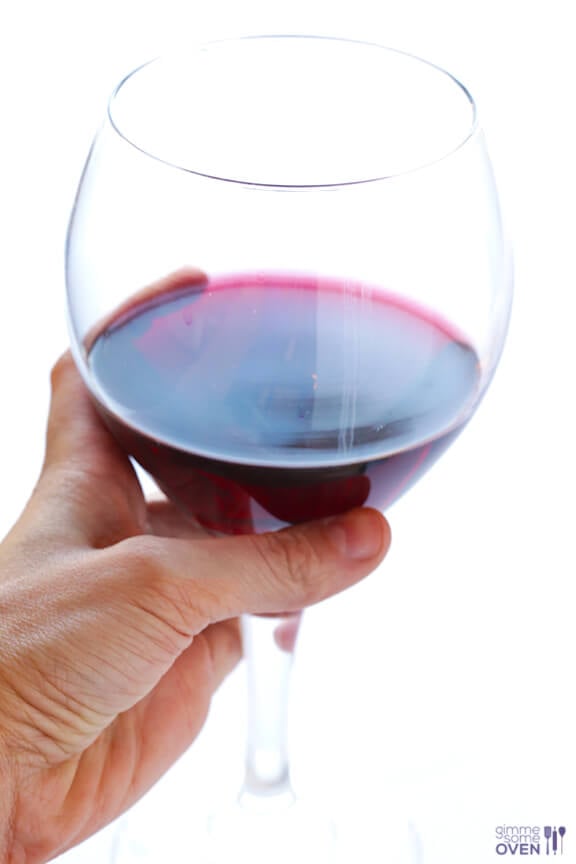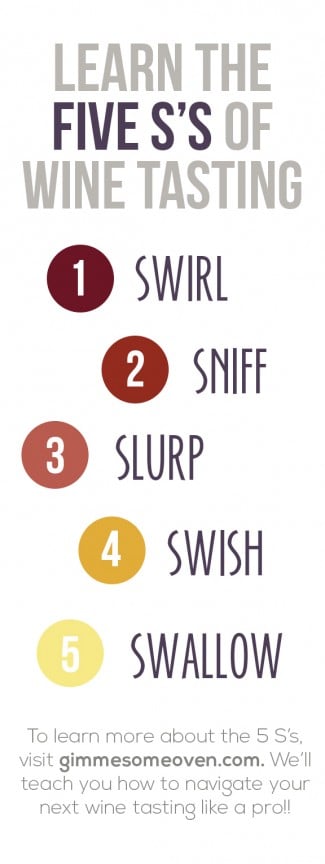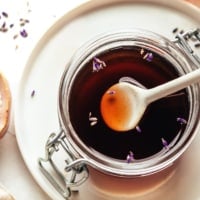The Five S’s of Wine Tasting
This post may contain affiliate links. Please read my disclosure policy.
We’re back with another post on our Gimme Sommelier series, where we are chatting it up about all things wine. Today, my friend Maureen is sharing with us about how to navigate a wine tasting like a pro. See if you can guess the 5 S’s!
Wine tastings can be confusing or intimidating. Moreso, if you’re not in wine country itself, you may be wondering where the heck to go for a wine tasting anyway! Well today, we are sharing five tips on how to be a pro wine-taster and fit right in with all of those “wine snobs” (who probably don’t know a whole lot more than you anyway!).
Just remember — wine tastings are all about having fun, getting to know different wine styles, and at the very least getting a free or cheap glass of wine out of the deal. No one is going to quiz you afterward, so relax and enjoy! For tasting events, seek out your local boutique wine shop (like mine and Ali’s favorite KC wine shop), many of which offer tastings on evenings and weekends for a small fee. Or, host your own an at-home wine tasting with friends from my previously recommended wines (more to come!).
Wherever you end up for a wine tasting, all you need to remember are the 5 S’s…
The 5 S’s of Wine Tasting:
1. Swirl
The first tip to enjoying a good red wine is ensuring that it’s properly aerated, and swirling it is one way to achieve some aeration if the bottle has just been opened (the other ways to achieve that include opening the bottle about 30 minutes prior to drinking, using a decanter, or using an aerator). Swirling is the reason that the wine glasses at a nice wine bar or winery seem gigantic compared to the individual serving of wine–because the shape and size of the glass allows you to swirl without spilling, and for the wine to have the largest air surface. No matter what type of red wine you’re drinking, the best and most classic glass is the “large bordeaux” style.
Needless to say–if you don’t have the right glass, just swirl carefully!
2. Sniff
As you know, our senses of taste and smell are very directly tied. So when you take a good long sniff of something, it will affect how you taste that something in the same moment. This, normally, is a good thing! Plus, a nice red wine just smells darn good. So, after you get some air into it, stick your nose well into that wine glass (as in, you should be dangerously close to dipping the tip of your nose into the juice!) and take a good long sniff. For some fun smell-testing, put only one nostril in for a sniff, and then the other–does it smell different in each nostril? Different than when we smell with your whole nose? Sometimes you can pick up different smells that way.
3. Slurp
Get some air in there! Another part of the aerating process is taking in air as you sip the wine into your mouth. So, as you take in some wine, make it sound like a straw trying to slurp up the last few drops out of a glass–get some air in there! This will continue to oxidate the wine and make it it’s best, full flavor.
4. Swish
Mouthwash style. That’s right–swish it around like you’re last dose of Listerine before a dentist office visit. This may seem odd and unsophisticated, but the goal is to get that wine on every part of your tastebuds. In the same way your nostrils may pick up different scents, different parts of your tongue will pick up different flavors. So you’ll get the full flavor of the wine only if it hits every one of your tastebuds.













My husband passed his level 1 sommelier test a few months ago, so I’m well versed in the 5 S’s lol. It takes him about 15 minutes of observing and sniffing before he even tastes it!
Katelyn // Relatively Offbeat
What a fun post! Basic, but pretty much the only things you need to know! You are making me want to go find some sweet Georgia wine!
Close, and probably close enough for most people, except…
Slurp and swish are really an attempt to do something that probably doesn’t start with S. The point of the noisy drawing of air (really post Slurp) that wine tasters make is not to aerate the wine, nor is it necessary to swish the wine around your mouth “to get it to all of your taste buds.” Your taste buds are on your tongue, not in your cheeks and gums.
The drawing of air is critical, because your mouth only tastes five things, while your nose can distinguished many more (maybe millions). There is a hole in the roof of your mouth, and drawing air across the wine in your mouth brings the odors to your nose. Much of what we consider as taste is actually smell, even once it is in our mouths. This is why food is flavorless when we have a cold and can not smell.
Swishing it around in your mouth is more about getting non wine tastes out of your mouth than anything else (and is the most optional step in your list).
I am taking the fun out of your simple all S line up, but myths aren’t necessary for enjoying wine.
The point you make about passing air through your nose is very interesting! I guess I always breath out of my nose when I have wine in my mouth to decipher the flavors better ( just noticed I did it with my coffee– haha), but I never knew the facts behind why it worked so well. Thanks for sharing!
I will add that I learned to “swish” red wine through your mouth so the tannin’s will attach to the protein there, instead of in your throat, making it challenging for some to enjoy dry wine. As I understand it, this is also the reason dry wine generally pairs well with meat. The tannin’s will attach to the protein in food, allowing you to experience the wine much differently. Very interesting stuff!
All these are very good but where comes the food? How important is it?
How expensive our daily bottle of wine should be in order to be sure in it’s good quality?
Thanks!
I always thought I was terrible at drinking wine, but I do most of these things. Wine tastes better to me after I swirl it, although I don’t slurp it… or swish because I’m not into wine-stained teeth =P Great post though! Love that you’re teaching us how to be a fancy wine drinker haha